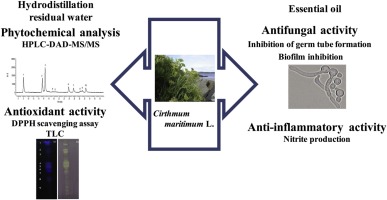Industrial Crops and Products ( IF 5.6 ) Pub Date : 2020-03-16 , DOI: 10.1016/j.indcrop.2020.112329 Jorge M. Alves-Silva , Inês Guerra , Maria José Gonçalves , Carlos Cavaleiro , Maria Teresa Cruz , Artur Figueirinha , Lígia Salgueiro

|
Aromatic and medicinal plants, such as those from the Apiaceae family, and their metabolites, namely essential oils are of great industrial interest and a source of biologically relevant compounds.
Essential oils are the major resource obtained during the hydrodistillation of aromatic plants, however, this process also originates high amounts of residual water. Although this by-product is discarded, it is conceivable that this water may be rich in non-volatile compounds which possess interesting biological properties. Therefore, the aim of this work is to analyze the oil and the hydrodistillation residual water of Crithmum maritimum L. (sea fennel), a highly aromatic plant widely used in many European countries and highlight the bioactive potential of both products. High performance liquid chromatography-photodiode array detector-mass spectrometry (HPLC-DAD-MS/MS) analysis of the hydrodistillation residual water showed a profile rich in hydroxycinnamic acids and small amounts of flavone and flavonol glycosides. Chemical analysis of the essential oil by gas chromatography coupled with mass spectrometry (GC-–MS) has revealed that γ-terpinene (33.6 %), sabinene (32.0 %) and thymol methyl ether (15.7 %) are the major compounds.
The antioxidant potential of the residual water was disclosed by the 2,2-Diphenyl-1-picrylhydrazyl (DPPH) radical scavenging assay and a composition-activity relationship was unveiled by thin layer chromatography (TLC). The anti-inflammatory potential was demonstrated by using an in vitro model of inflammation (lipopolysaccharide (LPS)-stimulated macrophages). Furthermore, the antifungal potential was evaluated by the capacity to inhibit two important virulence factors in Candida albicans.
Our results show that the residual water have a promising antioxidant potential as measured by DPPH scavenging assay (IC50 of 650 ± 160 μg/mL). Chlorogenic acid and quercetin derivatives found in the hydrodistillation residual water are the mainly contributors for this activity. The essential oil of C. maritimum (3.125 μg/mL) decreases the production of nitric oxide in LPS-stimulated macrophages by 37 % without affecting cell viability. In addition, the essential oil has a strong effect on virulence factors of C. albicans through inhibiting the formation of the germ tube by more than 50 % at 30 μg/mL besides, it is able to inhibit biofilm formation by decreasing both the biomass and the cell viability.
Summing up, the present work highlights that the essential oil of Crithmum maritimum and the non-volatile extract rich in hydroxycinnamic acids and flavonoid glycosides, obtained after the hydrodistillation process have important biological activities, thus endorsing the industrial exploitation of this plant.
中文翻译:

GC-MS和HPLC-DAD-MS / MS分析海事Cri精油和加氢精馏残留水的化学组成及其生物学活性
诸如菊科的那些的芳香和药用植物及其代谢产物,即精油,具有重要的工业价值并且是生物相关化合物的来源。
香精油是芳香植物加氢蒸馏过程中获得的主要资源,但是,此过程也产生大量的残留水。尽管该副产物被丢弃,但是可以想象,该水可能富含具有令人感兴趣的生物学特性的非挥发性化合物。因此,这项工作的目的是分析海鲈的油和加氢蒸馏残留水。L.(海茴香)是一种高度芳香的植物,在许多欧洲国家中广泛使用,并突出了这两种产品的生物活性潜力。加氢蒸馏残留水的高效液相色谱-光电二极管阵列检测器质谱(HPLC-DAD-MS / MS)分析表明,该色谱图富含羟基肉桂酸以及少量的黄酮和黄酮糖苷。通过气相色谱-质谱联用(GC-MS)对精油进行化学分析表明,主要成分为γ-萜品烯(33.6%)、,烯(32.0%)和百里酚甲基醚(15.7%)。
通过2,2-二苯基-1-吡啶并肼基(DPPH)自由基清除测定法揭示了残留水的抗氧化剂潜力,并通过薄层色谱法(TLC)揭示了组成-活性关系。通过使用体外炎症模型(脂多糖(LPS)刺激的巨噬细胞)证明了抗炎潜力。此外,通过抑制白色念珠菌中两个重要毒力因子的能力来评估抗真菌潜力。
我们的结果表明,通过DPPH清除测定(IC 50为650±160μg/ mL)测量,残留水具有良好的抗氧化潜力。加氢蒸馏残留水中发现的绿原酸和槲皮素衍生物是该活性的主要贡献者。海上梭状芽胞杆菌的精油(3.125μg/ mL)可将LPS刺激的巨噬细胞中一氧化氮的产生降低37%,而不会影响细胞活力。此外,精油通过以30μg/ mL的浓度抑制胚芽管的形成超过50%,对白色念珠菌的致病因子有很强的作用,此外,它还可以通过减少生物量和抑制生物膜的形成来抑制生物膜的形成。细胞活力。
综上所述,目前的工作着重指出,在水蒸馏后获得的海蓟花精油和富含羟基肉桂酸和类黄酮糖苷的非挥发性提取物具有重要的生物学活性,因此支持该植物的工业开发。











































 京公网安备 11010802027423号
京公网安备 11010802027423号